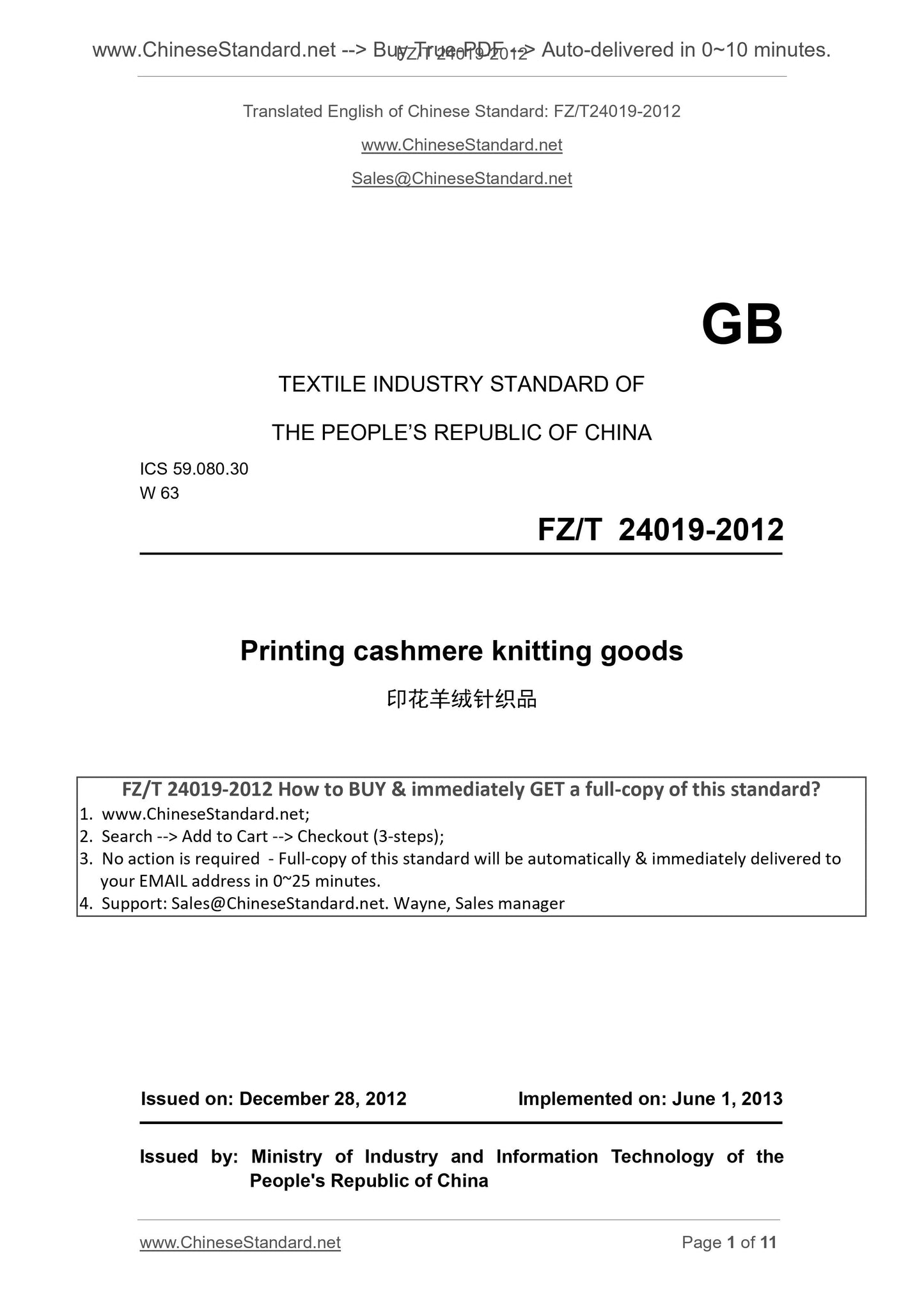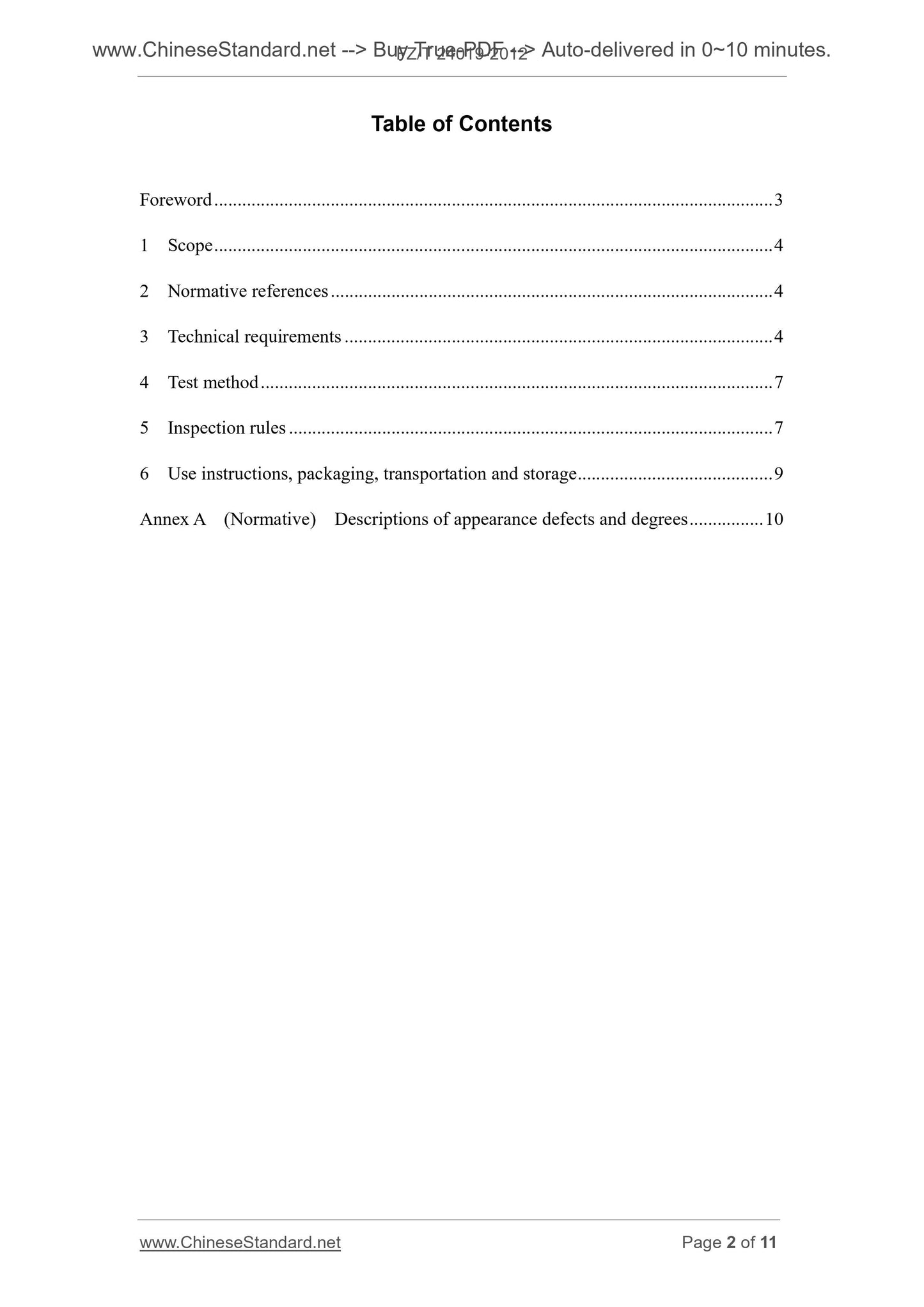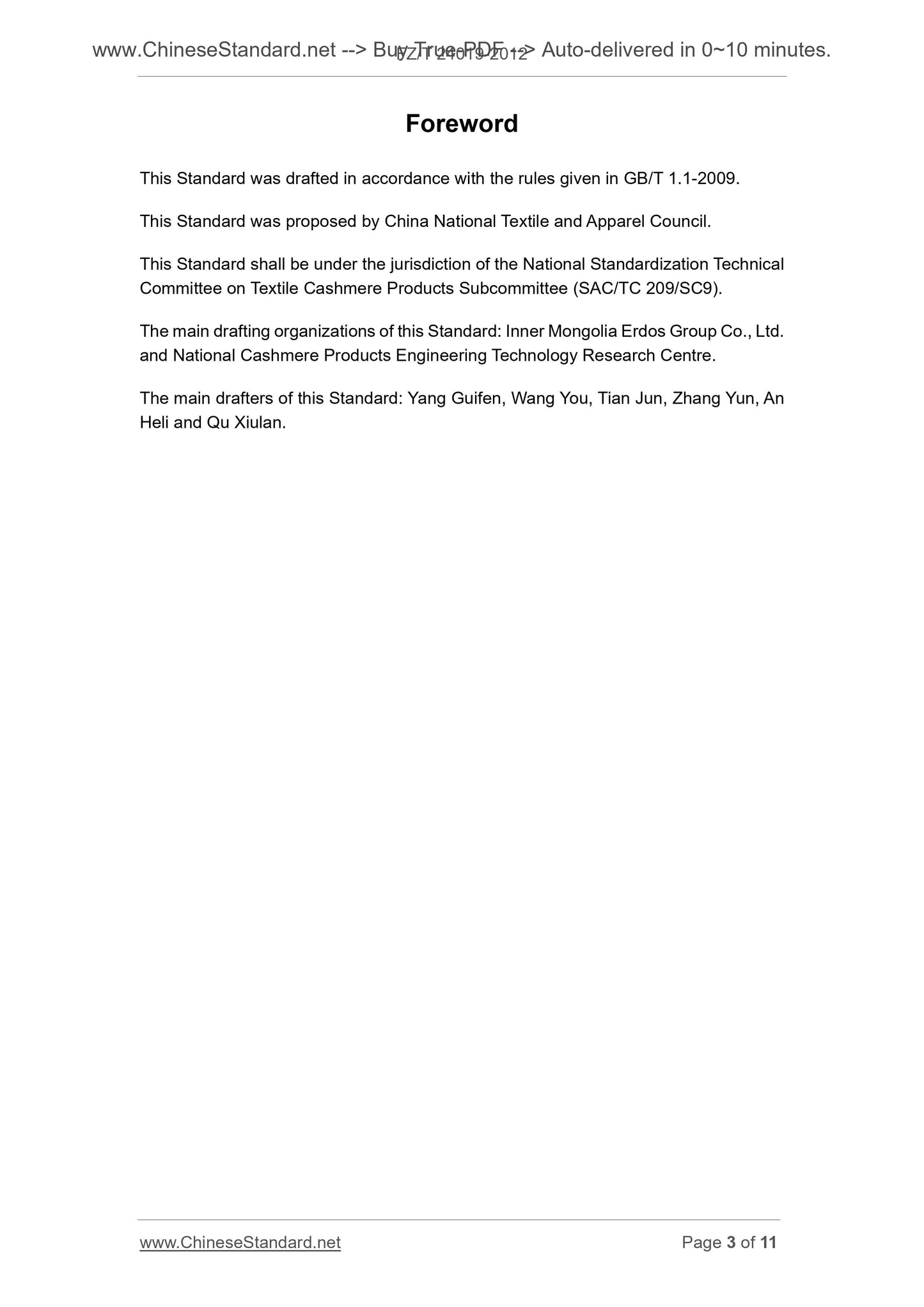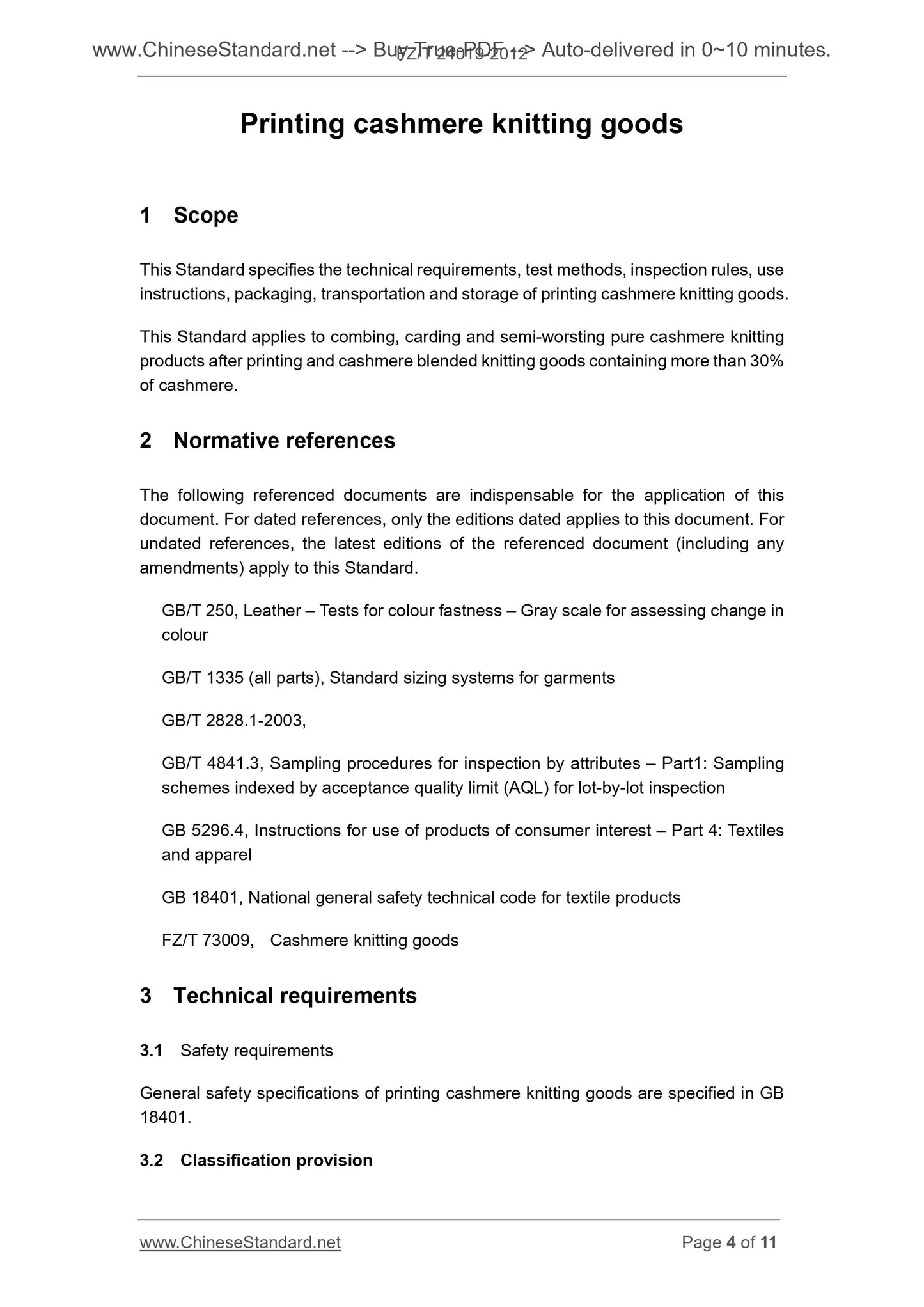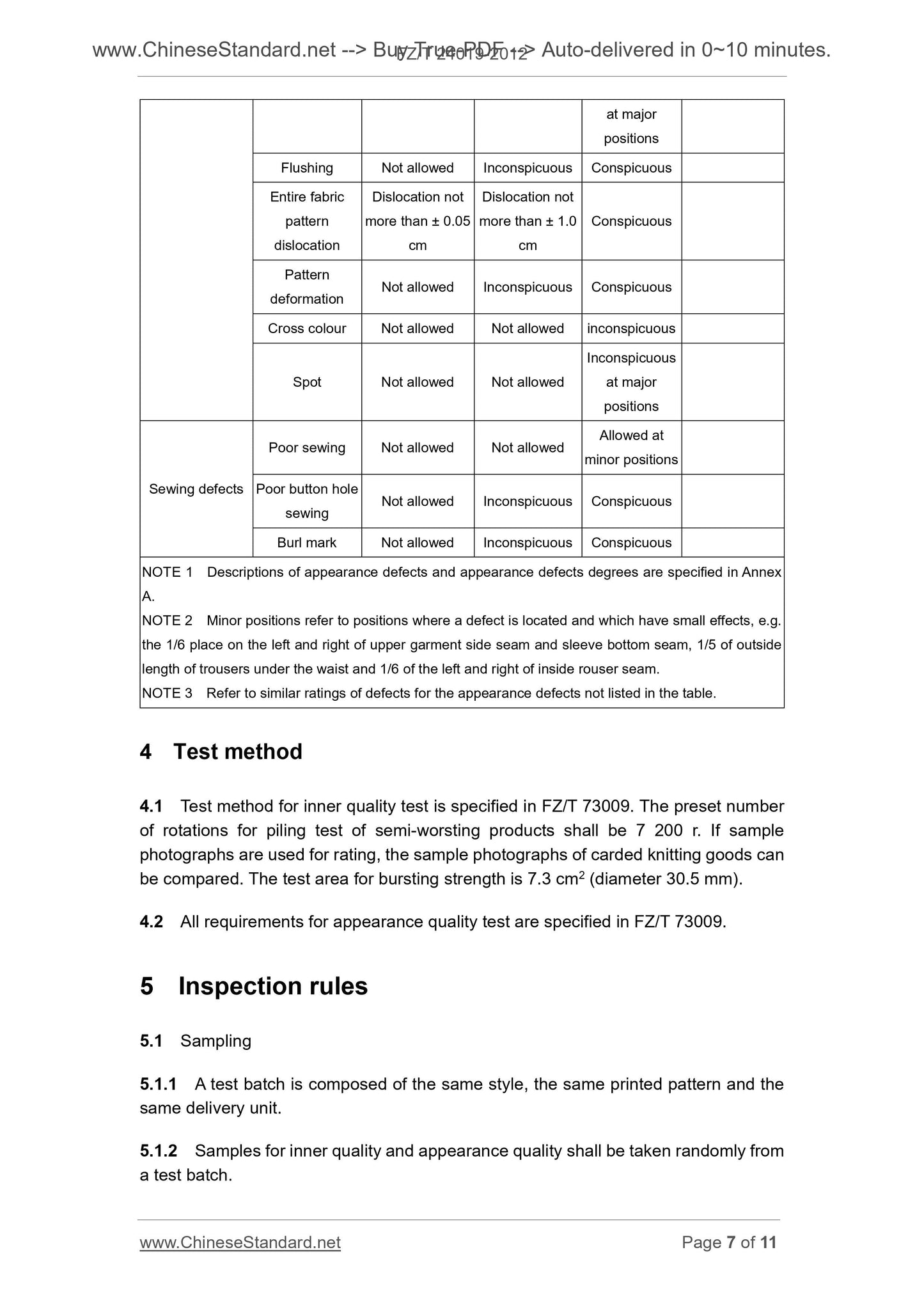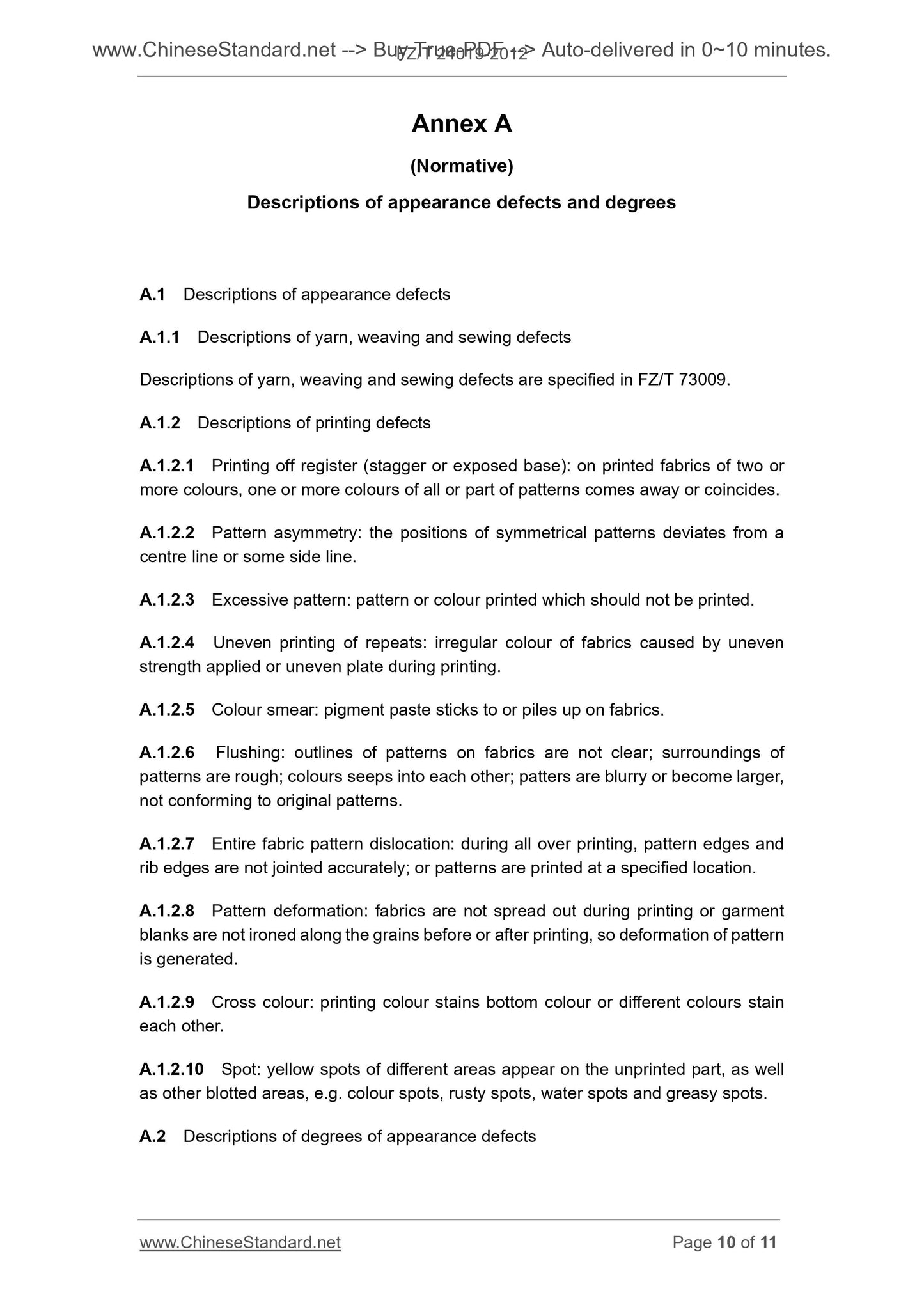PayPal, credit cards. Download editable-PDF and invoice in 1 second!
FZ/T 24019-2012 English PDF (FZT24019-2012)
FZ/T 24019-2012 English PDF (FZT24019-2012)
Precio habitual
$150.00 USD
Precio habitual
Precio de oferta
$150.00 USD
Precio unitario
/
por
Los gastos de envío se calculan en la pantalla de pago.
No se pudo cargar la disponibilidad de retiro
Delivery: 3 seconds. Download true-PDF + Invoice.
Get QUOTATION in 1-minute: Click FZ/T 24019-2012
Historical versions: FZ/T 24019-2012
Preview True-PDF (Reload/Scroll if blank)
FZ/T 24019-2012: Priting cashmere knitting goods
FZ/T 24019-2012
GB
TEXTILE INDUSTRY STANDARD OF
THE PEOPLE’S REPUBLIC OF CHINA
ICS 59.080.30
W 63
Printing cashmere knitting goods
印花羊绒针织品
ISSUED ON. DECEMBER 28, 2012
IMPLEMENTED ON. JUNE 1, 2013
Issued by. Ministry of Industry and Information Technology of the
People's Republic of China
Table of Contents
Foreword ... 3
1 Scope ... 4
2 Normative references ... 4
3 Technical requirements ... 4
4 Test method ... 7
5 Inspection rules ... 7
6 Use instructions, packaging, transportation and storage ... 9
Annex A (Normative) Descriptions of appearance defects and degrees ... 10
Foreword
This Standard was drafted in accordance with the rules given in GB/T 1.1-2009.
This Standard was proposed by China National Textile and Apparel Council.
This Standard shall be under the jurisdiction of the National Standardization Technical
Committee on Textile Cashmere Products Subcommittee (SAC/TC 209/SC9).
The main drafting organizations of this Standard. Inner Mongolia Erdos Group Co., Ltd.
and National Cashmere Products Engineering Technology Research Centre.
The main drafters of this Standard. Yang Guifen, Wang You, Tian Jun, Zhang Yun, An
Heli and Qu Xiulan.
Printing cashmere knitting goods
1 Scope
This Standard specifies the technical requirements, test methods, inspection rules, use
instructions, packaging, transportation and storage of printing cashmere knitting goods.
This Standard applies to combing, carding and semi-worsting pure cashmere knitting
products after printing and cashmere blended knitting goods containing more than 30%
of cashmere.
2 Normative references
The following referenced documents are indispensable for the application of this
document. For dated references, only the editions dated applies to this document. For
undated references, the latest editions of the referenced document (including any
amendments) apply to this Standard.
GB/T 250, Leather – Tests for colour fastness – Gray scale for assessing change in
colour
GB/T 1335 (all parts), Standard sizing systems for garments
GB/T 2828.1-2003,
GB/T 4841.3, Sampling procedures for inspection by attributes – Part1. Sampling
schemes indexed by acceptance quality limit (AQL) for lot-by-lot inspection
GB 5296.4, Instructions for use of products of consumer interest – Part 4. Textiles
and apparel
GB 18401, National general safety technical code for textile products
FZ/T 73009, Cashmere knitting goods
3 Technical requirements
3.1 Safety requirements
General safety specifications of printing cashmere knitting goods are specified in GB
18401.
3.2 Classification provision
at major
positions
Flushing Not allowed Inconspicuous Conspicuous
Entire fabric
pattern
dislocation
Dislocation not
more than ± 0.05
cm
Dislocation not
more than ± 1.0
cm
Conspicuous
Pattern
deformation Not allowed Inconspicuous Conspicuous
Cross colour Not allowed Not allowed inconspicuous
Spot Not allowed Not allowed
Inconspicuous
at major
positions
Sewing defects
Poor sewing Not allowed Not allowed Allowed at minor positions
Poor button hole
sewing Not allowed Inconspicuous Conspicuous
Burl mark Not allowed Inconspicuous Conspicuous
NOTE 1 Descriptions of appearance defects and appearance defects degrees are specified in Annex
A.
NOTE 2 Minor positions refer to positions where a defect is located and which have small effects, e.g.
the 1/6 place on the left and right of upper garment side seam and sleeve bottom seam, 1/5 of outside
length of trousers under the waist and 1/6 of the left and right of inside rouser seam.
NOTE 3 Refer to similar ratings of defects for the appearance defects not listed in the table.
4 Test method
4.1 Test method for inner quality test is specified in FZ/T 73009. The preset number
of rotations for piling test of semi-worsting products shall be 7 200 r. If sample
photographs are used for rating, the sample photographs of carded knitting goods can
be compared. The test area for bursting strength is 7.3 cm2 (diameter 30.5 mm).
4.2 All requirements for appearance quality test are specified in FZ/T 73009.
5 Inspection rules
5.1 Sampling
5.1.1 A test batch is composed of the same style, the same printed pattern and the
same delivery unit.
5.1.2 Samples for inner quality and appearance quality shall be taken randomly from
a test batch.
Annex A
(Normative)
Descriptions of appearance defects and degrees
A.1 Descriptions of appearance defects
A.1.1 Descriptions of yarn, weaving and sewing defects
Descriptions of yarn, weaving and sewing defects are specified in FZ/T 73009.
A.1.2 Descriptions of printing defects
A.1.2.1 Printing off register (stagger or exposed base). on printed fabrics of two or
more colours, one or more colours of all or part of patterns comes away or coincides.
A.1.2.2 Pattern asymmetry. the positions of symmetrical patterns deviates from a
centre line or some side line.
A.1.2.3 Excessive pattern. pattern or colour printed which should not be printed.
A.1.2.4 Uneven printing of repeats. irregular colour of fabrics caused by uneven
strength applied or uneven plate during printing.
A.1.2.5 Colour smear. pigment paste sticks to or piles up on fabrics.
A.1.2.6 Flushing. outlines of patterns on fabrics are not clear; surroundings of
patterns are rough; colours seeps into each other; patters are blurry or become larger,
not conforming to original patterns.
A.1.2.7 Entire fabric pattern dislocation. during all over printing, pattern edges and
rib edges are not jointed accurately; or patterns are printed at a specified location.
A.1.2.8 Pattern deformation. fabrics are not spread out during printing or garment
blanks are not ironed along the grains before or after printing, so deformation of pattern
is generated.
A.1.2.9 Cross colour. printing colour stains bottom colour or different colours stain
each other.
A.1.2.10 Spot. yellow spots of different areas appear on the unprinted part, as well
as other blotted areas, e.g. colour spots, rusty spots, water spots and greasy spots.
A.2 Descriptions of degrees of appearance defects
Get QUOTATION in 1-minute: Click FZ/T 24019-2012
Historical versions: FZ/T 24019-2012
Preview True-PDF (Reload/Scroll if blank)
FZ/T 24019-2012: Priting cashmere knitting goods
FZ/T 24019-2012
GB
TEXTILE INDUSTRY STANDARD OF
THE PEOPLE’S REPUBLIC OF CHINA
ICS 59.080.30
W 63
Printing cashmere knitting goods
印花羊绒针织品
ISSUED ON. DECEMBER 28, 2012
IMPLEMENTED ON. JUNE 1, 2013
Issued by. Ministry of Industry and Information Technology of the
People's Republic of China
Table of Contents
Foreword ... 3
1 Scope ... 4
2 Normative references ... 4
3 Technical requirements ... 4
4 Test method ... 7
5 Inspection rules ... 7
6 Use instructions, packaging, transportation and storage ... 9
Annex A (Normative) Descriptions of appearance defects and degrees ... 10
Foreword
This Standard was drafted in accordance with the rules given in GB/T 1.1-2009.
This Standard was proposed by China National Textile and Apparel Council.
This Standard shall be under the jurisdiction of the National Standardization Technical
Committee on Textile Cashmere Products Subcommittee (SAC/TC 209/SC9).
The main drafting organizations of this Standard. Inner Mongolia Erdos Group Co., Ltd.
and National Cashmere Products Engineering Technology Research Centre.
The main drafters of this Standard. Yang Guifen, Wang You, Tian Jun, Zhang Yun, An
Heli and Qu Xiulan.
Printing cashmere knitting goods
1 Scope
This Standard specifies the technical requirements, test methods, inspection rules, use
instructions, packaging, transportation and storage of printing cashmere knitting goods.
This Standard applies to combing, carding and semi-worsting pure cashmere knitting
products after printing and cashmere blended knitting goods containing more than 30%
of cashmere.
2 Normative references
The following referenced documents are indispensable for the application of this
document. For dated references, only the editions dated applies to this document. For
undated references, the latest editions of the referenced document (including any
amendments) apply to this Standard.
GB/T 250, Leather – Tests for colour fastness – Gray scale for assessing change in
colour
GB/T 1335 (all parts), Standard sizing systems for garments
GB/T 2828.1-2003,
GB/T 4841.3, Sampling procedures for inspection by attributes – Part1. Sampling
schemes indexed by acceptance quality limit (AQL) for lot-by-lot inspection
GB 5296.4, Instructions for use of products of consumer interest – Part 4. Textiles
and apparel
GB 18401, National general safety technical code for textile products
FZ/T 73009, Cashmere knitting goods
3 Technical requirements
3.1 Safety requirements
General safety specifications of printing cashmere knitting goods are specified in GB
18401.
3.2 Classification provision
at major
positions
Flushing Not allowed Inconspicuous Conspicuous
Entire fabric
pattern
dislocation
Dislocation not
more than ± 0.05
cm
Dislocation not
more than ± 1.0
cm
Conspicuous
Pattern
deformation Not allowed Inconspicuous Conspicuous
Cross colour Not allowed Not allowed inconspicuous
Spot Not allowed Not allowed
Inconspicuous
at major
positions
Sewing defects
Poor sewing Not allowed Not allowed Allowed at minor positions
Poor button hole
sewing Not allowed Inconspicuous Conspicuous
Burl mark Not allowed Inconspicuous Conspicuous
NOTE 1 Descriptions of appearance defects and appearance defects degrees are specified in Annex
A.
NOTE 2 Minor positions refer to positions where a defect is located and which have small effects, e.g.
the 1/6 place on the left and right of upper garment side seam and sleeve bottom seam, 1/5 of outside
length of trousers under the waist and 1/6 of the left and right of inside rouser seam.
NOTE 3 Refer to similar ratings of defects for the appearance defects not listed in the table.
4 Test method
4.1 Test method for inner quality test is specified in FZ/T 73009. The preset number
of rotations for piling test of semi-worsting products shall be 7 200 r. If sample
photographs are used for rating, the sample photographs of carded knitting goods can
be compared. The test area for bursting strength is 7.3 cm2 (diameter 30.5 mm).
4.2 All requirements for appearance quality test are specified in FZ/T 73009.
5 Inspection rules
5.1 Sampling
5.1.1 A test batch is composed of the same style, the same printed pattern and the
same delivery unit.
5.1.2 Samples for inner quality and appearance quality shall be taken randomly from
a test batch.
Annex A
(Normative)
Descriptions of appearance defects and degrees
A.1 Descriptions of appearance defects
A.1.1 Descriptions of yarn, weaving and sewing defects
Descriptions of yarn, weaving and sewing defects are specified in FZ/T 73009.
A.1.2 Descriptions of printing defects
A.1.2.1 Printing off register (stagger or exposed base). on printed fabrics of two or
more colours, one or more colours of all or part of patterns comes away or coincides.
A.1.2.2 Pattern asymmetry. the positions of symmetrical patterns deviates from a
centre line or some side line.
A.1.2.3 Excessive pattern. pattern or colour printed which should not be printed.
A.1.2.4 Uneven printing of repeats. irregular colour of fabrics caused by uneven
strength applied or uneven plate during printing.
A.1.2.5 Colour smear. pigment paste sticks to or piles up on fabrics.
A.1.2.6 Flushing. outlines of patterns on fabrics are not clear; surroundings of
patterns are rough; colours seeps into each other; patters are blurry or become larger,
not conforming to original patterns.
A.1.2.7 Entire fabric pattern dislocation. during all over printing, pattern edges and
rib edges are not jointed accurately; or patterns are printed at a specified location.
A.1.2.8 Pattern deformation. fabrics are not spread out during printing or garment
blanks are not ironed along the grains before or after printing, so deformation of pattern
is generated.
A.1.2.9 Cross colour. printing colour stains bottom colour or different colours stain
each other.
A.1.2.10 Spot. yellow spots of different areas appear on the unprinted part, as well
as other blotted areas, e.g. colour spots, rusty spots, water spots and greasy spots.
A.2 Descriptions of degrees of appearance defects
Share
